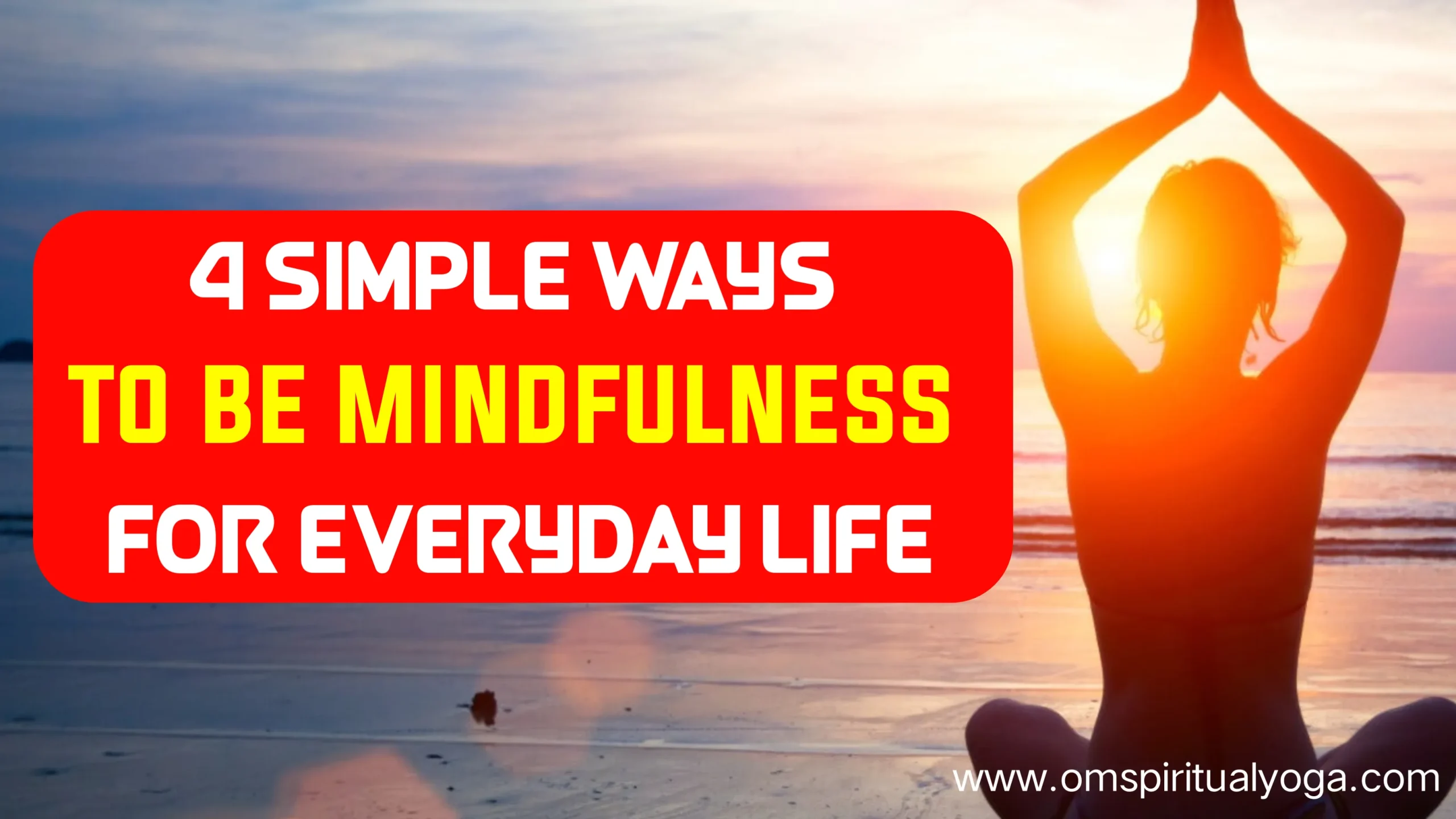Hey there, lovely readers! It’s Sumit, and I’m thrilled to have you back on my yoga blog, omspiritualyoga. If you’re new here, a warm welcome to you! I’m a yoga instructor and meditation guide, and I love sharing my insights through these articles. For those returning, it’s great to have you back, and I’m grateful for your continued support.
Today, I’m settling into my cozy meditation chair, ready to dive into a topic that’s incredibly close to my heart: mindfulness. And of course, I’ve got a steaming cup of soothing ginger tea by my side. Now, don’t worry, I’m not meditating just yet, but we’ll touch on that a bit later.
So, let’s get right into it! In this article, I want to share some practical tips on how you can infuse mindfulness into your daily life seamlessly. I’ve compiled four actionable suggestions that can be easily incorporated into your everyday routine. Let’s dive in!
Tip 1: Mindful Eating: Just like our bodies, our minds need training in order to function at their best. Mindfulness can be seen as a form of mental training that helps support the mind to become more effective, more focused, and more present in our day-to-day experiences. It’s often described as the practice of bringing your full attention in an open, non-judgmental way to the present moment. I like to think of mindfulness as a form of acceptance as well, meaning that we are paying attention to our thoughts and feelings without judging them. So, without believing, for instance, that there’s a way that we should or shouldn’t think or feel in a given moment.
You can help develop and strengthen your mindfulness muscles by consciously bringing yourself into the present moment with everyday activities that you’re doing in your routine. So, I am going to be offering four tips for you today on how you can do that.

Tip 1: Part 2 – Cultivating Mindful Eating: The first tip is all about mindful eating. Mindful eating is simply a way to improve your relationship with food. It’s there to help you get rid of or change any unwanted behaviors or thoughts around food in general. Mindful eating is not a specific diet; it’s just a way to bring more awareness to the types of foods you select, the types of foods you eat, and even how you prepare and eat your food.
One way I like to cultivate more mindfulness around the food that I eat is right before I eat a meal. I like to say a short prayer of gratitude and think about how the food in front of me got on my plate. I just like to thank farmers, grocery workers, animals, just for providing nutrients, energy, and life for myself, for my body, for my overall health. I’ve noticed that taking that time to pause before eating and finding that gratitude opens up a whole new sense of appreciation for food.
Also, it kind of trains you to be slower. Just pausing, taking your time to appreciate your food. In Ayurveda, they say you want to chew each bite of food 32 times. So, the way you eat is more important than what you actually eat.
Tip 1: Part 3 – Avoiding Distractions: It’s really interesting. Taking a moment to find gratitude, saying a short prayer before you eat, eating slowly, and trying to avoid distractions, like eating in front of the TV or with your phone on the table, really trying to find time to sit down, have a meal with your family or yourself, and just being fully present in that moment.
Tip 1: Part 4 – Mindful Sponsor Integration: Since we’re on the topic of mindfulness and health, I thought I’d introduce you guys to today’s sponsor, which is Ritual. Ritual is a vitamin company committed to sourcing nutrients straight from suppliers, leaving out artificial flavors, synthetic fillers, and other misleading ingredients found in many alternative vitamins. Everything is sourced with integrity and responsibility. They only contain nutrients in forms your body actually uses.
I’ve been taking the Essential for Women multivitamin, which comes with 60 vegan capsules. It has a nice minty fresh taste, and I take about two per day. You can see all the ingredients listed on their website; they’re very transparent about everything. If you’re interested in trying out Ritual for yourself, I have a link down below. They offer free shipping and a 30-day money-back guarantee.
Tip 1: Part 5 – Conclusion: One final point about mindful eating and mindfulness in general: it’s important to remember that we’re human, and we’re not perfect. We’re going to make mistakes along the way. I think it’s essential to hold space for ourselves when we do slip up or make mistakes and to be kind with ourselves throughout the process. When there are moments where we’re being unmindful, if we’re able to become aware of that and reflect on the effects it has on ourselves, it really goes a long way.
Tip 2: Being Mindful on social media: The second tip I’d like to share revolves around our use of social media. It’s an integral part of our daily routines, and if you’re reading this, chances are you’re active on social platforms. Personally, as someone who works extensively online, I find myself using social media almost daily. This has prompted me to reevaluate how I engage online, the content I produce, and to be more conscious of its impact on others. So, I’m here to provide some guidance on how you too can use social media in a more mindful and considerate manner.
Tip 2: Part 2 – Curating Your Social Media Feed: Number one is to clean out your feed. On YouTube, you have subscribers, and on Instagram, you have people you follow. I think it’s essential to follow people who bring you good energy, who uplift you. If you’re following negative people who are always complaining or even news sources that are jarring, be mindful of that. If you have people like that on your feed, all that negative energy is being absorbed into yourself.
For me, I only follow people who are uplifting and inspiring. That way, when I’m scrolling on social media, I am subconsciously taking in only positive information, and it really makes a difference. So, maybe go through your friends’ list, see who you follow, and be more mindful of the thoughts and feelings that come up for you when you’re scrolling on social media.
Tip 2: Part 3 – Non-Judgmental Approach: Just notice if you’re scrolling because you’re bored, notice if there’s a post that makes you sad, jealous, or upset, and just really be curious about what emotions are coming up. It’s essential to be non-judgmental during this process. If negative feelings come up, don’t judge yourself; just remind yourself it’s okay. Be curious and wonder why a post made you feel a certain way.
Tip 2: Part 4 – Letting Go of Validation: Another point to consider is when posting on social media, let go of all attachment to the outcome. Don’t expect a certain number of likes or comments. The likes you get have nothing to do with your worth as a human being, as a content creator, as an artist. As long as you love what you’re doing, that’s all that matters. Let go of your attachment to any outcomes.
Tip 3: Being Present in Conversations: The third tip for mindfulness is about being more present in conversations. In this age of technology, we’re often on our phones and computers, and meaningful conversations and connections have become rarer. Being present in day-to-day interactions and conversations is something we need to come back to.
Tip 3: Part 2 – Mindful Conversation: Using mindfulness in communication means truly taking the time to be present within a conversation. This might look like maintaining eye contact with someone, holding space for them, being mindful of their emotions and body language. In order to achieve this, it means setting ourselves aside for a moment so that this person can share this interaction with us.
Tip 3: Part 3 – Understanding Without Judgment: Another point to consider when trying to engage in mindful conversation is to try to understand what the other person is saying without judgment or criticism. If someone says something that offends you, it’s important to learn how to respond versus react. Take a moment to pause, listen to what they’re saying, and respond in a calm and respectful way. This shows your emotional maturity and makes for a more meaningful conversation.
Tip 4: Meditation and Journaling: My final tip for you today is to be open to exploring meditation and journaling. These are creative outlets and tools that can help cultivate more mindfulness on a daily basis.
Tip 4: Part 2 – Meditation: Meditation sharpens our focus and expands our awareness by allowing us to find time to be still from the busyness of our lives and dive deep into the roots of our experiences.
Tip 4: Part 3 – Journaling: Journaling is a very similar practice to meditation. Writing can be therapeutic. When you put your thoughts down on paper, you clear your mind, provide new insights into situations, and release old stagnant energy or thoughts you might be holding onto.
CONCLUSION: I really do recommend at least being open to the idea of journaling. You can spend just 20 minutes each day, which isn’t long at all. Start with five minutes of movement, five minutes of meditation, five minutes of journaling, and another five minutes of meditation. Having this routine consistently will help you cultivate more mindfulness in your practice and your everyday life.
The more we practice our mindfulness muscle, the stronger it becomes, and we can use it in day-to-day things like conversations, eating, and social media. It’s a practice we have to tap into and be conscious of every day.
